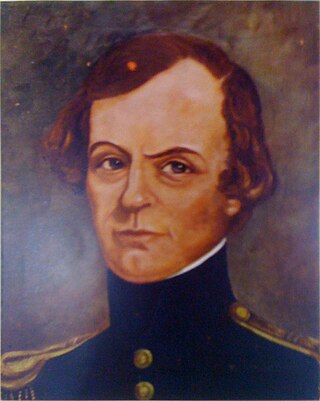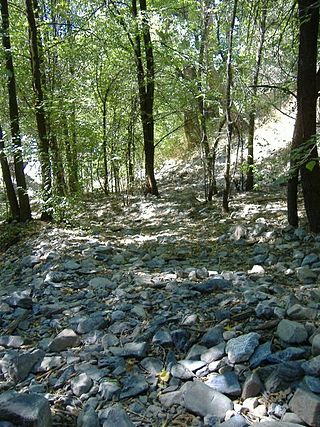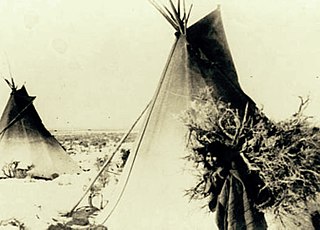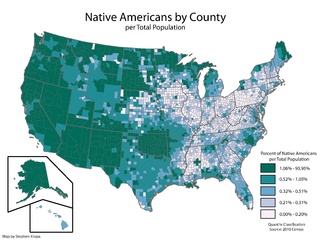Related Research Articles

Manti is a city in and the county seat of Sanpete County, Utah, United States. The population was 3,276 at the 2010 United States Census.

The Mountain Meadows Massacre was a series of attacks during the Utah War that resulted in the mass murder of at least 120 members of the Baker–Fancher emigrant wagon train. The massacre occurred in the southern Utah Territory at Mountain Meadows, and was perpetrated by settlers from the Church of Jesus Christ of Latter-day Saints involved with the Utah Territorial Militia who recruited and were aided by some Southern Paiute Native Americans. The wagon train, made up mostly of families from Arkansas, was bound for California, traveling on the Old Spanish Trail that passed through the Territory.

The Goshutes are a tribe of Western Shoshone Native Americans. There are two federally recognized Goshute tribes today:

John Williams Gunnison was an American military officer and explorer.
Antonga, or Black Hawk, was a nineteenth-century war chief of the Timpanogos Tribe in what is the present-day state of Utah. He led the Timpanogos against Mormon settlers and gained alliances with Paiute and Navajo bands in the territory against them during what became known as the Black Hawk War in Utah (1865–1872). Although Black Hawk made peace in 1867, other bands continued raiding until the US intervened with about 200 troops in 1872. Black Hawk died in 1870 from a gunshot wound he received while trying to rescue a fallen warrior, White Horse, at Gravely Ford Richfield, Utah, June 10, 1866. The wound never healed and complications set in.
Chief Walkara was a Shoshone leader of the Utah Indians known as the Timpanogo and Sanpete Band. It is not completely clear what cultural group the Utah or Timpanogo Indians belonged to, but they are listed as Shoshone. He had a reputation as a diplomat, horseman and warrior, and a military leader of raiding parties, and in the Wakara War.

The History of Utah is an examination of the human history and social activity within the state of Utah located in the western United States.

The Black Hawk War, or Black Hawk's War, is the name of the estimated 150 battles, skirmishes, raids, and military engagements taking place from 1865 to 1872, primarily between Mormon settlers in Sanpete County, Sevier County and other parts of central and southern Utah, and members of 16 Ute, Southern Paiute, Apache and Navajo tribes, led by a local Ute war chief, Antonga Black Hawk. The conflict resulted in the abandonment of some settlements and hindered Mormon expansion in the region.
Mormons have numerous significant instances of violence throughout their history as a religious group. In the early history of the United States, violence was used as a form of control. According to Mormon history, their members have faced persecution and forceful expulsion from where they have settled, such as being driven from Ohio to Missouri and from Missouri to Illinois during the lifetime of church founder Joseph Smith. Soon, those that followed one of Smith's successors Brigham Young settled in the Utah Territory and became the largest denomination of the Latter Day Saint movement, the LDS Church. Church history records that their migrations were accompanied by acts of violence that included massacres, home burnings, and pillaging.
The pursuit of the perpetrators of the Mountain Meadows massacre, which atrocity occurred September 11, 1857, had to await the conclusion of the American Civil War to begin in earnest.

The Battle Creek massacre was a lynching of a Timpanogos group on March 5, 1849, by a group of 35 Mormon settlers at Battle Creek Canyon near present-day Pleasant Grove, Utah. It was the first violent engagement between the settlers who had begun coming to the area two years before, and was in response to reported cattle theft by the group. The attacked group was outnumbered, outgunned, and had little defense against the militia that crept in and surrounded their camp before dawn. The massacre had been ordered by Brigham Young, the Utah territory governor and president of the Church of Jesus Christ of Latter-day Saints (LDS). The formation of the Mormon settlement of Utah Valley soon followed the attack at Battle Creek. One of the young survivors from the group of 17 children, women, and men who had been attacked grew up to be Antonga Black Hawk, a Timpanogos leader in the Black Hawk War.

The Pahvant or Pahvants were a band of Ute people that lived in present-day Utah. Called the "Water People", they fished and hunted waterfowl. They were also farmers and hunter-gatherers. In the 18th century they were known to be friendly and attentive, but after a chief's father was killed by emigrating white settlers, a group of Pahvant Utes killed John Williams Gunnison and seven of his men during his exploration of the area. The bodies of water of their homeland were dried up after Mormons had diverted the water for irrigation. Having intermarried with the Paiutes, they were absorbed into the Paiute Indian Tribe of Utah and relocated to reservations.

The Fountain Green massacre was an incident in 1853 near Fountain Green, Utah when a group of Utes killed four Mormons. The next day, Mormons in nearby Nephi, Utah killed eight Goshutes who had no connection to the earlier killings.

The following outline is provided as an overview of and a topical guide to the Church of Jesus Christ of Latter-day Saints.
The Battle at Fort Utah was a violent attack in 1850 in which 90 Mormon militiamen surrounded an encampment of Timpanogos families on the Provo River one winter morning, and laid siege for two days, eventually shooting between 40 and 100 Native American men and one woman with guns and a cannon during the attack as well as during the pursuit and capture of the two groups that fled the last night. One militiaman died from return fire during the siege. Of the Timpanogos people who fled in the night, one group escaped southward, and the other ran east to Rock Canyon. Both groups were captured, however, and the men were executed. Over 40 Timpanogos children, women, and a few men were taken as prisoners to nearby Fort Utah. They were later taken northward to the Salt Lake Valley and sold as slaves to church members there. The bodies of up to 50 Timpanogos men were beheaded by some of the settlers and their heads put on display at the fort as a warning to the mostly women and children prisoners inside.

Indigenous peoples have lived in the area now known as the state of Utah for thousands of years. Today they are divided into five main groups: Utes, Goshutes, Paiutes, Shoshone, and Navajo. Each occupies a different region within the state, many of which regions extend across borders into other states. In the 2010 census, there were a total of 32,927 American Indian and Alaska Natives living within the state, which totaled to 1.19% of the total population of Utah.
Wakara's War, also known as Walker's War was a dispute between the Paiute Indians and the Mormon settlers in the Utah Valley. This war is characterized as a string of disputes and skirmishes over property and the land from July 1853 to May 1854. This war was influenced by factors such as religious differences, the slave trade, and the division of the Salt Lake Valley.

Over the past two centuries, the relationship between Native American people and Mormonism has included friendly ties, displacement, battles, slavery, education placement programs, and official and unofficial discrimination. Native American people were historically considered a special group by adherents of the Latter Day Saint movement (Mormons) since they were believed to be the descendants of the Lamanite people described in The Book of Mormon. There is no support from genetic studies and archaeology for the historicity of the Book of Mormon or Middle Eastern origins for any Native American peoples. Today there are many Native American members of Mormon denominations as well as many people who are critical of Mormonism and its teachings and actions around Native American people.
The Circleville Massacre was an 1866 lynching of 27 Southern Paiute Native American men, women, and children by members of Mormonism's largest denomination the Church of Jesus Christ of Latter-day Saints in Circleville, Utah.
References
- ↑ Stettler, Jeremiah (September 15, 2006). "Skeletons found in Nephi may reveal details of 1853 massacre". Salt Lake Tribune . Retrieved May 7, 2023.
[The archaeologist] has found nothing to change the history of the Nephi massacre. Rather, he has evidence to suggest that seven men, ages 16 to 25, were killed that day and thrown in a mass grave.
- 1 2 "Nephi Indian grave yields details of 1853 killings". Deseret News . LDS Church. Associated Press. June 8, 2007. Retrieved May 7, 2023.
- 1 2 3 Rood, Ronald (2012). "Massacre in Nephi: Archaeology of a Mass Grave". The Beehive Archive. Salt Lake City: Utah Humanities. Retrieved May 7, 2023.
- ↑ Rood, Ronald J. (2017). "The Archaeology of a Mass Grave from Nephi, Utah and One Event of the Walker War, Utah Territory. Excavations at 42JB1470, Nephi, Utah". In Kiarszys, Grzegorz; Zalewska, Anna Izabella (eds.). Materiality of Troubled Pasts: Archaeologies of Conflicts and Wars. Szczecin, Poland: University of Szczecin. ISBN 978-83-943365-3-0 – via ResearchGate.
- ↑ Wimmer, Ryan (December 13, 2010). The Walker War Reconsidered (Master of History thesis). Brigham Young University.
- ↑ Carter, D. Robert (February 18, 2006). "Frontier violence traumatized both colonists and Indians". Daily Herald . Retrieved May 2, 2023.
- 1 2 Trauntvein, Myrna (August 9, 2006). "Skeletal remains found at construction site in Nephi". Nephi Times-News . Nephi, Utah. Retrieved August 17, 2016.
- ↑ Christy, Howard A. (January 1, 1979). "The Walker War: Defense and Conciliation as Strategy". Utah Historical Quarterly . 47 (4): 395–420. doi:10.2307/45060728. ISSN 0042-143X. JSTOR 45060728. S2CID 254442937.
- ↑ Bagley, Will (October 17, 2019). The Whites Want Every Thing: Indian-Mormon Relations, 1847–1877. University of Oklahoma Press. ISBN 9780806165813.
- ↑ Trauntvein, Myrna (June 27, 2007). "Native American remains reveal evidence of being executed". Nephi Times-News . Nephi, Utah. Retrieved August 17, 2016.